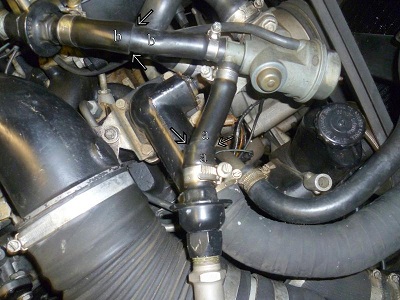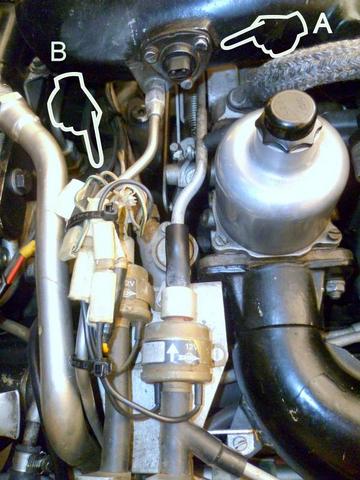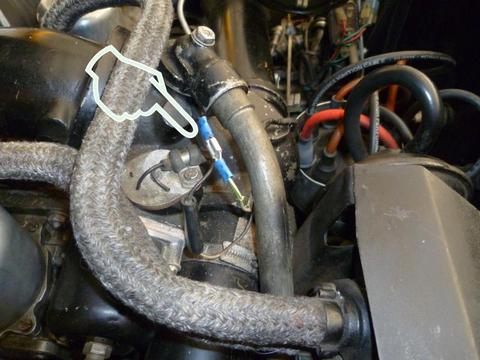| Author | Message | ||
KC Unregistered guest Posted From: 168.210.90.232 |
Hi all After changing the spark plugs on my 1970 Shadow the car seems to idle much faster than before. The auto choke works, so that does not seem to be the cause of this. Previously, when cold starting the auto choke would cause the car to idle fast, but a blip of the accelerator would return the idle speed to normal. Now it just keeps idling fast, even when the butterfly is open, which I can tell from the position of the actuator arm. Is there an easy way of adjusting the idling speed, or do I need the services of a SU expert? This has happened once before, but the problem seemed to go away by itself, so I’m not convinced that the changing of spark plugs caused this. Besides, the old plugs seemed to be in good condition, except for the last plug on B-bank, which was never changed by the previous owner due to its inaccessibility! I had to remove the heater tap and pipes to get to it. Regards | ||
Richard Treacy Grand Master Username: richard_treacy Post Number: 147 Registered: 4-2003 |
Idle speed is dead simple to adjust. There is an obvious setscrew with a locknut (3/8 inch ? maybe smaller, but I forget) by the carburettors. However, it sounds more like you have simply knocked off a vacuum hose somewhere (eg feed to distributor, cruise control etc). That will push the idle up to maybe 1,000rpm. | ||
KC Unregistered guest Posted From: 168.210.90.232 |
Thanks Richard, I’ll have a good look for loose pipes first. As for the idle setscrew, are there two (one per carburettor), or is there just one? Are you able to give me a basic description of its location? I appreciate your advice! Regards KC | ||
Richard Treacy Grand Master Username: richard_treacy Post Number: 148 Registered: 4-2003 |
There is just one setscrew for the fast idle setting once the motor has warmed up. From memory it is located at the active end of the throttle return spring. It is rather obvious. There another adjustment for the choke: be sure not to disturb the one on the choke fast idle cam. The correct one parks on a solid surface, not the cam. | ||
Bill Coburn Grand Master Username: bill_coburn Post Number: 128 Registered: 4-2003 |
One other place to look is the fast idle cam itself. They do stick and sit up in the high position. A good squirt of WD40 and a wiggle and that should justify/throw out the window that diagnosis. | ||
Peter Dixon Frequent User Username: petenlinid Post Number: 75 Registered: 8-2003 |
I have followed the advice in the above postings hoping to fix a similar problem without success. When I start the car from cold the choke fast idle engages and the engine runs at about 1300rpm and steadily increases as the car warms up to about 2000rpm. Each attempt to blip the throttle to release the leaver from the cam causes the revs to rise to the 2000rpm point more quickly. Once the engine reaches normal working temperature it will/may/sometimes blip off. At my last attempt to work out what is happening I was unable to make the blip factor work (panicked,again) and turned the engine off. As I stood there studying and abusing the SU's, the adjusting screw slipped off the cam all by itself. I assume stopping the engine caused the temperature to rise sufficiently to make make something or other activate. Once the fast idle has ceased the engine runs normally. As the car until recent times has always started and run well, I am reluctant to interfere/experiment with the original settings. It was my understanding the automatic choke progressively reduces the engine revs and that the rate of reduction is directly related to temperature, and once the fast idle cam was set if the car was left to warm up it would eventually come to normal idle status. Is this correct. Any suggestions as always will be greatly appreciated. Cheers Peter | ||
Hubert Kelly Experienced User Username: h_kelly Post Number: 17 Registered: 3-2012 |
Hi Peter, had a similar problem last year.Do you depress the accelerator prior to starting the car to allow choke to come on?. If you do, try starting the Rolls on a warm day and avoid using accelerator, till car warms up.... say 5 minutes. Another way to view the problem, ask someone to turn the ignition on while your(under the bonnet) looking for the choke mechanism to engage.Another way might be, turn the ignition on, depress the accelerator from under the hood (with engine off) a see what kind of grip the choke mechanism has( you will need a small spanner and screw driver to adjust. I noticed on my own car a "tooth" had formed on a particular part of the choke "stopped" it might be something to consider.I used loads of 3in 1 oil also. HK | ||
Jeff Young Frequent User Username: jeyjey Post Number: 92 Registered: 10-2010 |
There are two separate systems here: the choke and the fast-idle cam. They are somewhat interelated, but only somewhat. Depressing the accelerator will engage the fast-idle if the choke is closed (cold), and will disengage it if the choke is open (hot). How open or closed the choke is will also vary the angle of the fast-idle cam. If the fast-idle cam is engaged, your RPM should be between 950 and something faster. If it's not engaged, it should be about 650. So if you depress the accelerator before starting and let the engine warm up, it will only come down to 950. It won't go all the way down to 650 until you press (or blip) the accelerator, thereby releasing the fast-idle cam. Jeff. | ||
Peter Dixon Frequent User Username: petenlinid Post Number: 77 Registered: 8-2003 |
Many thanks for your comments gentlemen. I will be having another crack at the problem today armed with your advice. Peter | ||
Peter Dixon Frequent User Username: petenlinid Post Number: 78 Registered: 8-2003 |
Following on forum advice I have located a pair of pipes that were separated. Please see the attached JPEG File. They each consist of two pieces of pipe of different sizes which are joined in the middle (marked as aa and bb) by inserting one inside the other and secured at each end with Jubilee clips. I am assuming that these pipes form a type of relief valve and are intended to separate under given conditions. Either that or some mechanic just botched them together from spare bits and pieces in the absence of properly moulded single pipes. Reinserting them has reduced the fast idle from 1500 – 1800 rpm to about 900 rpm. Once the engine has reached normal temperature and idle speed 650-700 rpm short sharp revs of the motor elicit mild popping noises in the exhaust. It is fine at normal acceleration. Could these joints which are close but not necessarily tight be responsible for sucking air into the manifold be causing this?  Thanks for any help. Peter | ||
Peter Dixon Frequent User Username: petenlinid Post Number: 79 Registered: 8-2003 |
Continuing: I was mistaken in my previous posting regarding the decrease in revs at fast idle. It is about 1600 rpm from a stone cold start. Left to warm up, instead of progressively decreasing it does the opposite. Readings taken every minute for 5 minutes were 1600 – 2000 – 2500 – 2800 – 3000 rpm. The cam did not appear to have moved, and failed to disengage when the accelerator was kicked down. By this time the engine was good and warm; concerned at the high rpm I turned her off. A couple of minutes later I flipped the throttle linkage under bonnet and the cam cleared instantly. I guess the increase of engine heat after stopping aided this process. The car then started easily and idled normally. I will leave her overnight and run the same test tomorrow to establish fault consistency. I should say I have had this car for nine years, done very low mileage in it in that time, and apart from the accumulators being overhauled and normal servicing it has had little engine compartment attention. It has been a delight in every regard. Driven recently by the need to replace the viscous coupling and power steering cooler hoses, I have become a little more familiar with all that funny stuff under the hood/bonnet. Through this process I have made the following observations on which I also would appreciate comment and advice; • There appears to be no E.G.R ‘full cut-out micro-switch’ or associated ‘drive link’ as depicted in Fig U37(14) & U37(1). I am not conscious of any adverse effect. • One of the wires leading into the automatic choke solenoid, Fig K88 (3) was disconnected. I think it has been this way for a ling time. It doesn’t seem to make any difference to the choke mechanism when I reconnected it. As I said the car appears to go really well but as my overall knowledge is a bit limited perhaps I don’t know what ‘really well’ really is. Peter | ||
Peter Dixon Frequent User Username: petenlinid Post Number: 80 Registered: 8-2003 |
Sorry folks, something I forgot to include in my last post. The 'weakening system cut-out switch' Fig K87(4) has nothing plugged into it. There is a neatly bundled and secured little bunch of wires above the 'weakening system cut off solenoid'. Its been like that ever since I got the car with no apparent ill effects. At least not to me. Should this or does this need to be reinstated. Once again thanks for any help. Peter | ||
Jeff Young Frequent User Username: jeyjey Post Number: 94 Registered: 10-2010 |
Hi Peter, My (home market) car doesn't have the hoses indicated, so I'm guessing that they're part of the air-pump system. (Does each one go to a set of "antlers" with the tips in the exhaust manifold?) If so, they're probably meant to blow apart if you get backfiring in the exhaust manifold. The purpose of the choke is to provide excess fuel to compensate for that which condenses out of the mixture onto the cold walls of the intake manifold. So if the choke were stuck in one position, as the intake manifold heated up, less fuel would condense out and the mixture would get richer and richer (resulting in faster and faster idle). So my guess is that something's a bit sticky in your choke system. I believe the weakening system cut-out switch is to disable the weakener during startup. The fact that it's not giving any trouble may indicate that the solenoid is stuck closed, and that the weakener is never working on your car. About the only side-effect that would have would be worse fuel economy (I think). Cheers, Jeff. | ||
Brian Vogel Frequent User Username: guyslp Post Number: 90 Registered: 6-2009 |
Peter, What you have pictured (aa & bb) are the hoses prior to the two check valves and these are indeed a part of the air injection system. I have a car that was originally home market that doesn't have air injection and another that was for US export that does. These hoses should each be a single section, not smaller hose within larger hose. I replaced the branches on mine with silicone tubing. Luckily the 'S' shaped molded piece between the air injection pump and the Y-piece is still fine. Additional photos of the other areas you're describing might help, too. Brian | ||
Peter Talbot Prolific User Username: squerryes Post Number: 139 Registered: 7-2010 |
Silicone tubing is a highly variable product produced by crosslinking (curing)a silicone elastomer to form a solid generally using addition(platinum) or free radical (peroxide) curing systems. Without going into a long discourse, for automative purposes either is acceptable provided of good quality. I would suggest avoid the cheap tubing from the local store and go for a high grade tubing from a specialist supplier. The best option would be a braid reinforced silicone hose such as that available from New Age Industries: http://www.newageindustries.com/silbrade-silicone-hose.asp. Peter | ||
Brian Vogel Frequent User Username: guyslp Post Number: 91 Registered: 6-2009 |
I wanted something that was black, so I went with the Black High Temperature, 3/4" ID, 1" OD, Silicone Tubing at McMaster Carr Brian | ||
Peter Dixon Frequent User Username: petenlinid Post Number: 81 Registered: 8-2003 |
Thanks everyone for your comments. Brian please see attached pics. 'A' is the point of the missing plug. 'B' is the bundle of wires. The others are of the wire, now joined that doesn't seem to effect running, connected or not.    | ||
Jeff Young Frequent User Username: jeyjey Post Number: 95 Registered: 10-2010 |
The wires coming out of the metal plate under the 3rd pointing finger are the choke solenoid, which is used to hold the choke closed when it's very cold (below freezing). I can't quite tell from the picture if those wires lead to the two blue plastic coated terminals your finger is pointing to or not. Your "A" finger is indeed pointing to the weakener cutout switch. The solenoid it powers is the one to the right of the one under the bundle of wires pointed to by your "B" finger. If the weakener cutout solenoid is frozen shut then you're just suffering from worse fuel mileage than you might otherwise. However, if it's open, then it's possible someone adjusted your idle way up to compensate for the fact that the weakener is not disabled during warm-up, which might explain your fast idle. Disconnect the solenoid and see if you can blow through it.... (FWIW, the other solenoid under the "B" bundle of wires is the anti-run-on solenoid.) Jeff. | ||
Brian Vogel Frequent User Username: guyslp Post Number: 92 Registered: 6-2009 |
Peter, The weakener solenoid and the anti-run-on (sometimes called anti-dieseling) solenoids are essentially two sides of the same coin in terms of how they operate. The anti-run-on solenoid is closed when energized (that is, when the key is in the start or run positions) and open when not (when you shut the car off). When it opens it applies vacuum to the carbs. The weakener solenoid is *open* when energized and it should only be energized once the cut-out switch is warmed up by the engine running. At start-up on a cold car the weakener solenoid should definitely be closed. If either is stuck you can try dosing them with penetrating oil and seeing if that allows them to operate again. It often will, and they'll keep going for quite a while (usually) if that works. If not, there are two Jaguar solenoids related to fuel system on the Jag that function as perfect substitutes for the originals. I have the part numbers if you need those [or you can download the RR & Bentley Parts, Repair, Restoration & Other Resources Compilation on Google Docs and search for "anti-run-on" and you'll find that info.] If you look at Chapter K of the workshop manual (starting at PDF page 25) the function of these solenoids is described as is the testing of function. I will try to snap some photos of my Shadow II's engine bay in that area at some point over the next few days. I have a problem with the ground wire not grounding for the weakener cut-off switch and the anti-dieseling solenoid so I had to rig an auxiliary ground for both several years ago. Since that works and fixed the immediate problem I put my efforts into more pressing issues. I do have a couple of unconnected bits in that area as well, but I can't see anything that suggests these were ever used for anything. Brian |